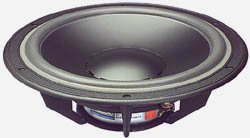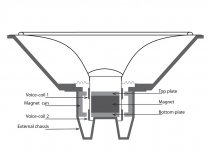Hello everyone! (Not sure where in the forums this question would sit, but I figured here would be most appropriate...)
I’m curious as to what the differences/effects are of having the voice coil sit outside of the magnet motor, as opposed to the more traditional approach of having the voice coil sit within the magnet motor...really, the biggest advantage I can think of is simply having a larger VC...though beyond that, it seems to escape me - hence my question to you all!
But I digress, many thanks in advance for your guys’ help and responses!
I’m curious as to what the differences/effects are of having the voice coil sit outside of the magnet motor, as opposed to the more traditional approach of having the voice coil sit within the magnet motor...really, the biggest advantage I can think of is simply having a larger VC...though beyond that, it seems to escape me - hence my question to you all!
But I digress, many thanks in advance for your guys’ help and responses!
Well, the origin of this question came about from seeing it on Morel’s Technology page on their site - they state their use of External Voice Coils (Unfortunately...that’s really the only name I can think of that states their usage of it, though I recall seeing it being discussed in the past before from some other manufacturers...sorry for not being able to provide more names...)
I went through the link (thanks charlie2). The voice coil is still inside the magnetic circuit. There isn't anything special about EVC except that they use a slug magnet, instead of a ring magnet, and the voice coil is extremely large. Neither of these really bring significant advantages in and of themselves. The extra power handling doesn't make sense in a non-pro audio application, and Morel isn't a huge name in PA anyway.Well, the origin of this question came about from seeing it on Morel’s Technology page on their site - they state their use of External Voice Coils (Unfortunately...that’s really the only name I can think of that states their usage of it, though I recall seeing it being discussed in the past before from some other manufacturers...sorry for not being able to provide more names...)
If you're interested in this sort of thing, though:
https://www.jblpro.com/pub/technote/JBL_TN 1-33 rev3.pdf
Thanks for link. Those Morel folks seem very smart.charlie2;5670121[url=https://www.morelhifi.com/technology/ said:INNOVATIVE TECHNOLOGY - Morel[/url]
The "external" coil goes along with the one-piece cone and the sophisticated math on which the cone shape is based. As with quality woofers of yesteryear (light cones with 4-inch VCs, sometimes aluminum wires), Morel is trying to be as piston-like as possible without badly compromising other desirable cone attributes. That's why you want to drive the cone from the largest diameter VC possible.
BTW, the hexagonal wire (which leaves less empty space than winding round wire in the VC) seems to be a variant of something common on quality drivers of yesteryear, "edge wound" flat wires (like my 1965 Stephens TruSonic woofer*). Maybe flat wire is hard to lay commercially and the hex wire spools better when laying out the VC.
From the perspective of good design (yesteryear or today), the 500 watt woofers of today with half-pound cone assemblies are an abomination.... which Morel is trying to combat.
B.
* I once destroyed a Western Electric "ball park" horn driver; it had flat aluminum windings on the VC.... maybe 1945???
Last edited:
These guys drive from the middle. This completely new design was done relatively recently.As with quality woofers of yesteryear (light cones with 4-inch VCs, sometimes aluminum wires), Morel is trying to be as piston-like as possible without badly compromising other desirable cone attributes. That's why you want to drive the cone from the largest diameter VC possible.
www.fohonline.com/images/stories/12/02/current/30.200.1202.pdf
- Status
- This old topic is closed. If you want to reopen this topic, contact a moderator using the "Report Post" button.
- Home
- Loudspeakers
- Multi-Way
- External Voice Coils?

